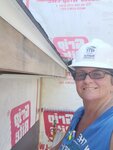


Both Monica and Claudia were more adept at construction projects than the average suburban gal. Our father was an architect and engineer – always working on some building or mechanical project when we were growing up. Our mother was a seamstress by trade and taught us both to sew when we were young. So construction came quite naturally to us and Monica frequently said, “The only difference between working with wood and fabric is that sewing requires a ⅝” seam allowance.”
Well, the tools and the materials are somewhat different too. But for both sewing and construction you need a plan (patterns vs. blueprints), materials (fabric vs. 2x4s), fasteners (thread vs. nails), and tools (scissors and sewing machines vs. circular saws and nail guns). We grew up watching father study and revise the blueprints on his drafting table and watching mother design and sew all of our dresses and coats. But to put it simply, both are: measure, cut, attach.
The chicken coop was the first farm construction project. Good friends Norm and Dawn promised to help Monica build the shed; in return, Monica would help them build a similar one on the far end of her property as their personal hunting blind. Perfect! Material lists were made; everything was ordered and delivered. Monica decided that the best location was between the pasture’s water hydrant and the pole barn – not too close to the house, not too far. Feed could be kept in the barn and a hose could easily be run from the hydrant.
Sections were laid out and air-nailed together in the pole barn – electricity and the air compressor were close at hand, and the barn kept everything (and us) protected from the March weather. An air framing nailer can be a bit intimidating at first, but it’s so fast! Monica (a bit impatient and an efficiency lover) quickly became quite adept at using it. Everyone – including the grandkids – helped carry the framed sections out to the location and secure them together. The younger kids helped nail the plywood siding to the frame; Monica’s college-aged grandson helped with the roofing.
By the time the exterior was finished, Monica felt completely competent (she’s a very good seamstress). Racks for the laying boxes were measured, cut, and assembled. Doors were constructed and hung. (Hinges are tricky – there is no sewing equivalent to hinges.) Used dog kennel panels made a lovely, protected run for the chickens.
By this time, Monica had added bottle-baby goats to her farm; soon they would need grass and hay, and the cattle feeders were just too big for the goats. And by winter the goats would need an enclosure in the barn, separate from the cattle. Monica had learned a lot building the chicken coop with Norm, but this was different. These things didn’t come with set patterns – they had to be designed from scratch – which she thought was half the fun.
And it was fun! Well, except that when you are designing and building, your initial plans don’t always work out. Monica quickly learned that removing nails that had been put in with compressed air was not at all fun … nearly impossible. So the air nailer was abandoned and torx-head screws (and her faithful Ryobi impact driver) were embraced. Easy in and easy out! Coming home from the next trip to Menards, Monica had six different varieties of screws and a second battery for the impact driver. She was ready!
The first goat feeder (designed to be part of the goat enclosure – very efficient) was perfect. Until the goats started climbing on it. And in it. Well-fed baby goats get bigger, and heavier, and love climbing up and over anything – hay feeders, hay bales, even cows eating hay. The goat feeder / enclosure was going to have to be redesigned (more than once over the years). Thank goodness for the screws.
Chickens grow too. They can easily hop onto the workbench in the pole barn – knocking and moving anything that was left loose (particularly screws which roll off the counter onto the dirt floor and threaten to puncture vehicle tires). Back to Home Depot for holding containers and magnets and more screws. And more 2x4s and plywood, of course. But all that wood takes up an inordinate amount of floor space and the next thing Monica built was a rack to hold all the new and scrap wood that was waiting for the next project idea.
Claudia didn’t really enjoy construction projects (she doesn’t like tools and doesn’t care much for sewing either). But she was great at finding lost screws with magnets (well, most of them), and reorganizing the work benches when they became piled with stuff (screws and discarded pieces of 2x4s and tools … “Hey Claudia! Have you seen the T-square? I can’t remember where I put it.”). And usually by the time construction was over for the day, Monica was done-done. To the rescue came Claudia – cleaning up all the scraps and putting the tools away. For Monica it was like having a fairy-godmother with a magic wand.
The sisters became quite a team! Claudia would hold the end of the tape measure while Monica designed the new screen room / firewood shelter on the deck. Or Monica would cut the plywood with the circular saw while Claudia steadied the 4’x8’ sheet. And Claudia would stand on the ladder, holding one end of the 2x4, while Monica attached it. Measure, cut, and fasten. Construction and sewing are very similar – except for that ⅝” seam allowance.